Travel and Tourism: Case Study and Report Writing
VerifiedAdded on 2023/01/10
|9
|2373
|91
AI Summary
This report discusses the theories, concepts, and models related to travel and tourism, as well as the scope of transport operations worldwide. It also explores the environmental impacts of cruise tourism and provides strategies for ensuring sustainable marine transport. The report concludes with a discussion on sustainability and future trends in transport for tourism.
Contribute Materials
Your contribution can guide someone’s learning journey. Share your
documents today.
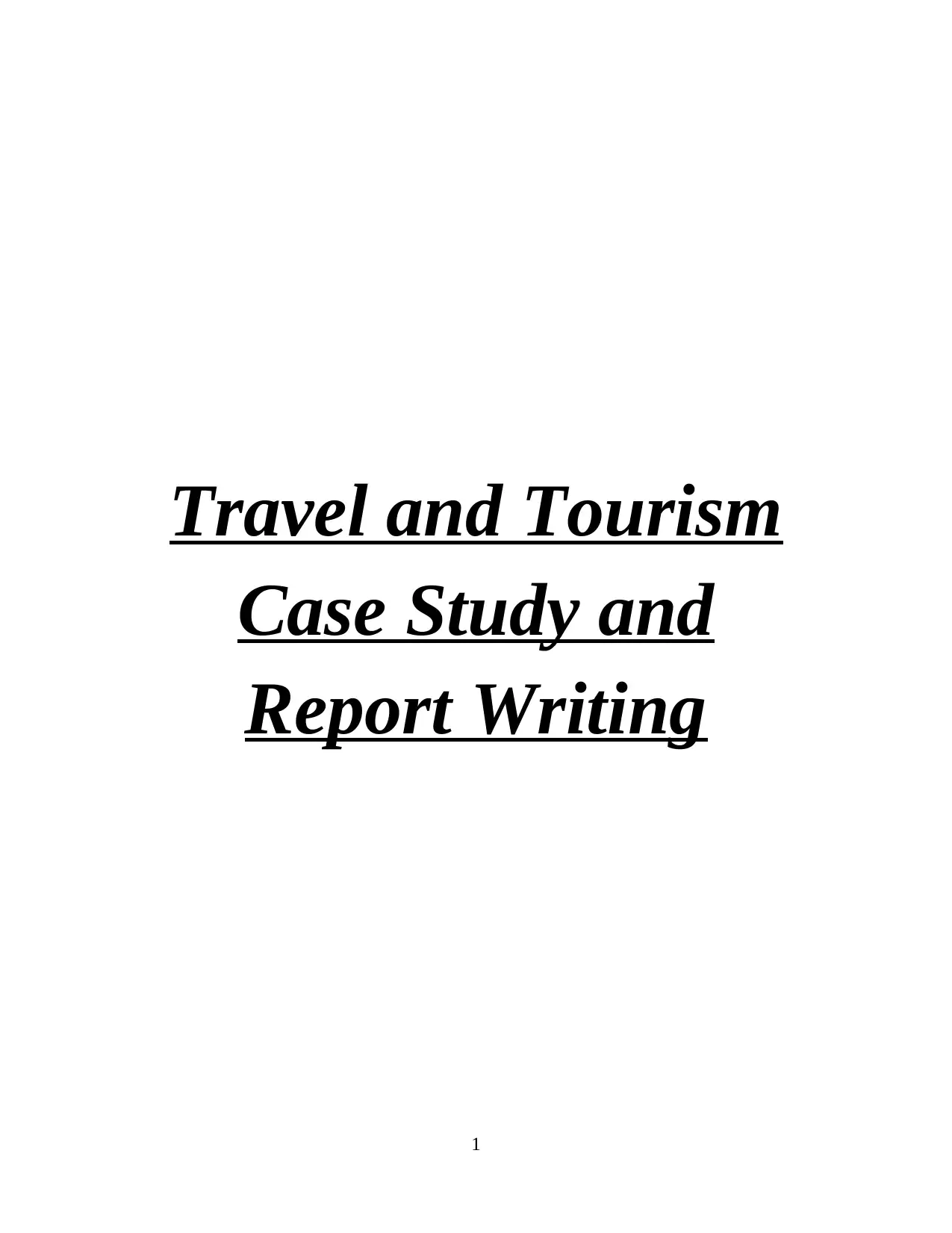
Travel and Tourism
Case Study and
Report Writing
1
Case Study and
Report Writing
1
Secure Best Marks with AI Grader
Need help grading? Try our AI Grader for instant feedback on your assignments.
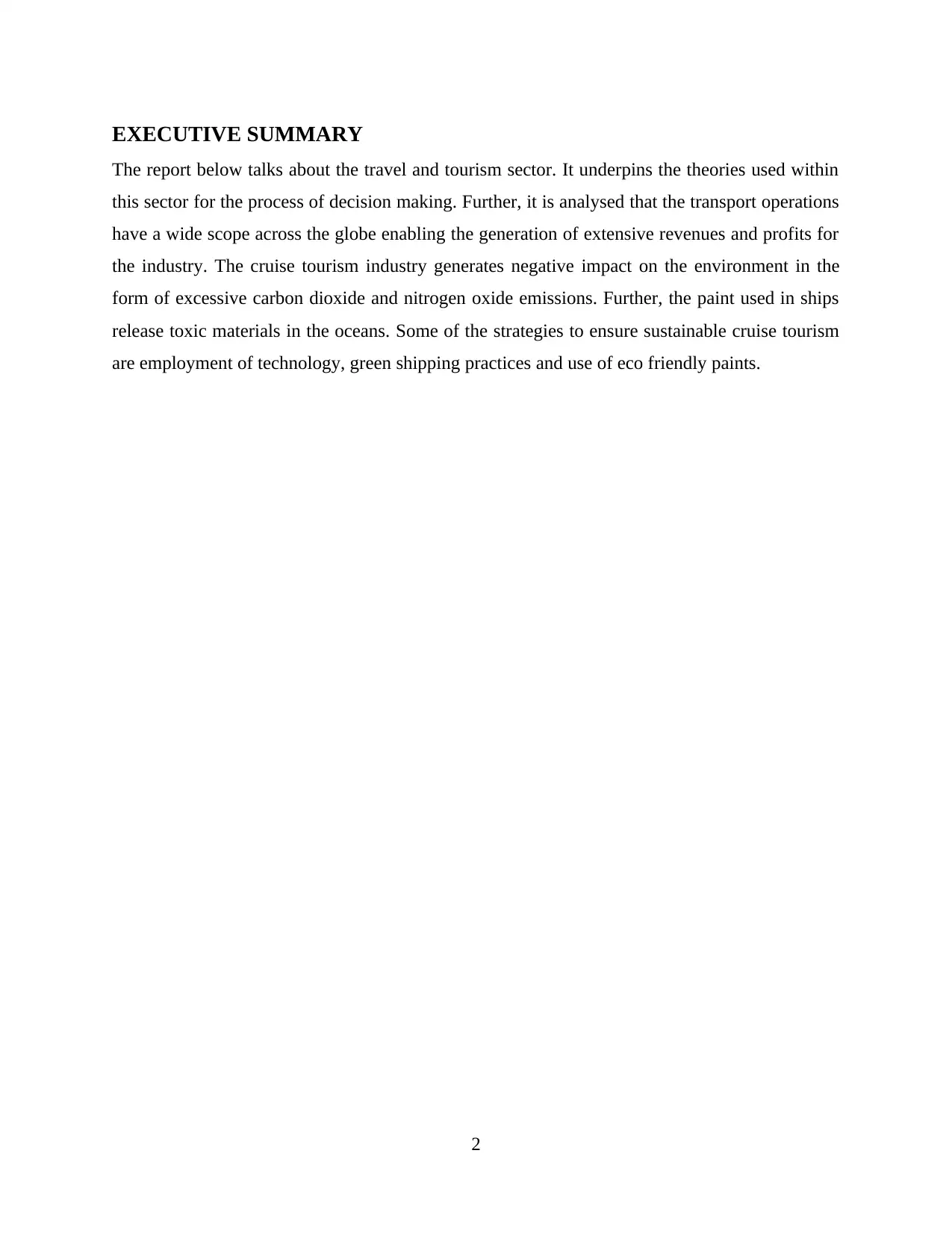
EXECUTIVE SUMMARY
The report below talks about the travel and tourism sector. It underpins the theories used within
this sector for the process of decision making. Further, it is analysed that the transport operations
have a wide scope across the globe enabling the generation of extensive revenues and profits for
the industry. The cruise tourism industry generates negative impact on the environment in the
form of excessive carbon dioxide and nitrogen oxide emissions. Further, the paint used in ships
release toxic materials in the oceans. Some of the strategies to ensure sustainable cruise tourism
are employment of technology, green shipping practices and use of eco friendly paints.
2
The report below talks about the travel and tourism sector. It underpins the theories used within
this sector for the process of decision making. Further, it is analysed that the transport operations
have a wide scope across the globe enabling the generation of extensive revenues and profits for
the industry. The cruise tourism industry generates negative impact on the environment in the
form of excessive carbon dioxide and nitrogen oxide emissions. Further, the paint used in ships
release toxic materials in the oceans. Some of the strategies to ensure sustainable cruise tourism
are employment of technology, green shipping practices and use of eco friendly paints.
2
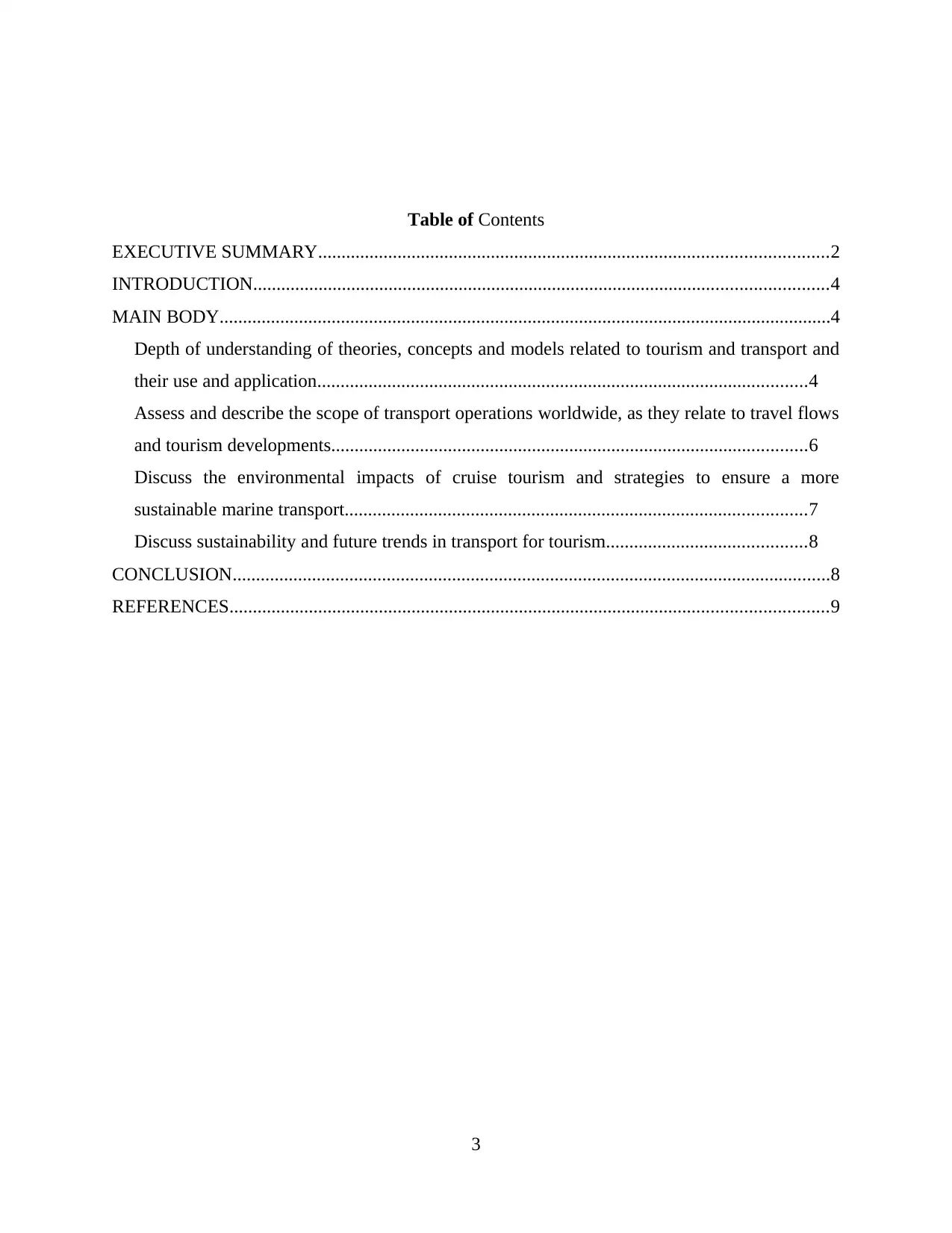
Table of Contents
EXECUTIVE SUMMARY.............................................................................................................2
INTRODUCTION...........................................................................................................................4
MAIN BODY...................................................................................................................................4
Depth of understanding of theories, concepts and models related to tourism and transport and
their use and application.........................................................................................................4
Assess and describe the scope of transport operations worldwide, as they relate to travel flows
and tourism developments......................................................................................................6
Discuss the environmental impacts of cruise tourism and strategies to ensure a more
sustainable marine transport...................................................................................................7
Discuss sustainability and future trends in transport for tourism...........................................8
CONCLUSION................................................................................................................................8
REFERENCES................................................................................................................................9
3
EXECUTIVE SUMMARY.............................................................................................................2
INTRODUCTION...........................................................................................................................4
MAIN BODY...................................................................................................................................4
Depth of understanding of theories, concepts and models related to tourism and transport and
their use and application.........................................................................................................4
Assess and describe the scope of transport operations worldwide, as they relate to travel flows
and tourism developments......................................................................................................6
Discuss the environmental impacts of cruise tourism and strategies to ensure a more
sustainable marine transport...................................................................................................7
Discuss sustainability and future trends in transport for tourism...........................................8
CONCLUSION................................................................................................................................8
REFERENCES................................................................................................................................9
3
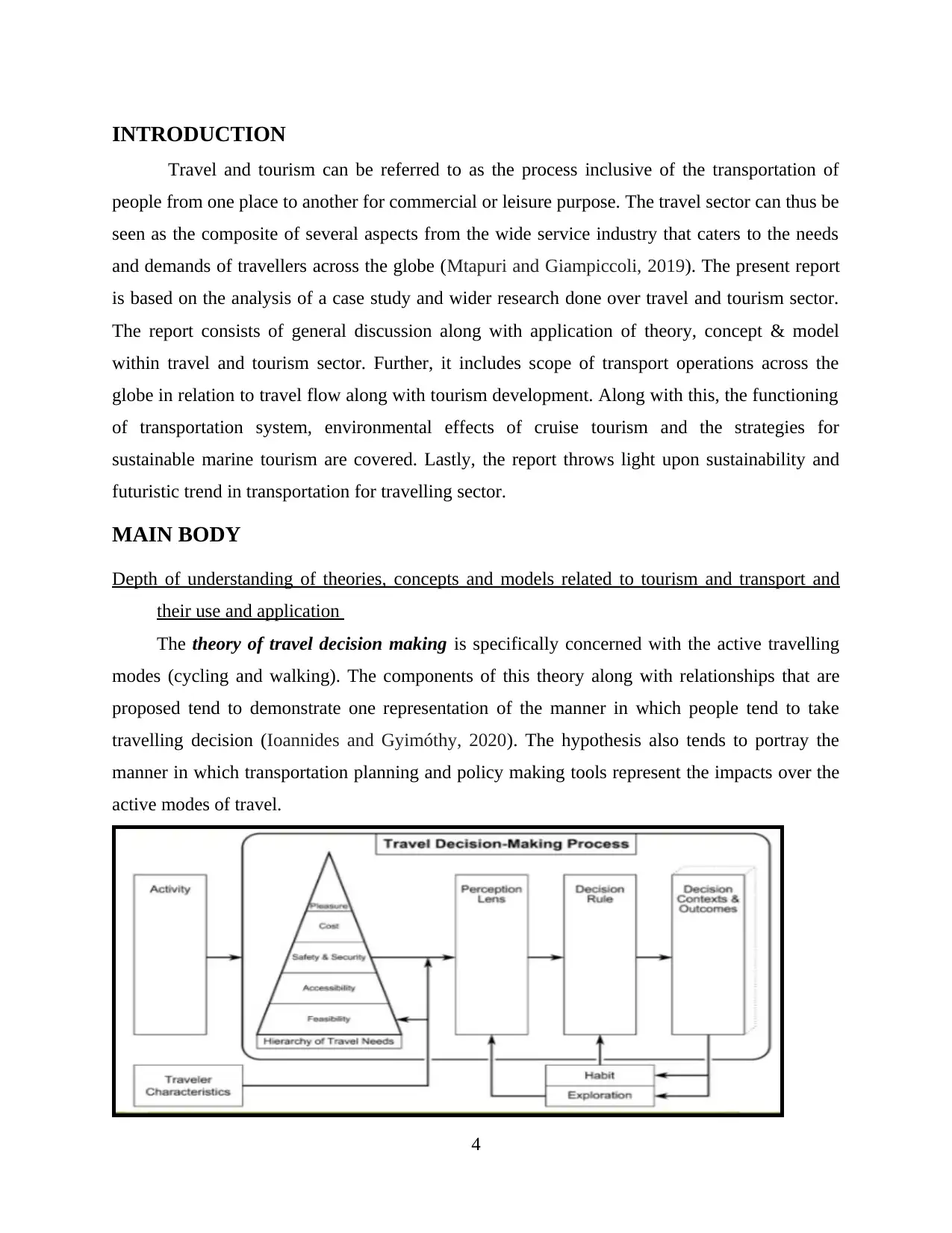
INTRODUCTION
Travel and tourism can be referred to as the process inclusive of the transportation of
people from one place to another for commercial or leisure purpose. The travel sector can thus be
seen as the composite of several aspects from the wide service industry that caters to the needs
and demands of travellers across the globe (Mtapuri and Giampiccoli, 2019). The present report
is based on the analysis of a case study and wider research done over travel and tourism sector.
The report consists of general discussion along with application of theory, concept & model
within travel and tourism sector. Further, it includes scope of transport operations across the
globe in relation to travel flow along with tourism development. Along with this, the functioning
of transportation system, environmental effects of cruise tourism and the strategies for
sustainable marine tourism are covered. Lastly, the report throws light upon sustainability and
futuristic trend in transportation for travelling sector.
MAIN BODY
Depth of understanding of theories, concepts and models related to tourism and transport and
their use and application
The theory of travel decision making is specifically concerned with the active travelling
modes (cycling and walking). The components of this theory along with relationships that are
proposed tend to demonstrate one representation of the manner in which people tend to take
travelling decision (Ioannides and Gyimóthy, 2020). The hypothesis also tends to portray the
manner in which transportation planning and policy making tools represent the impacts over the
active modes of travel.
4
Travel and tourism can be referred to as the process inclusive of the transportation of
people from one place to another for commercial or leisure purpose. The travel sector can thus be
seen as the composite of several aspects from the wide service industry that caters to the needs
and demands of travellers across the globe (Mtapuri and Giampiccoli, 2019). The present report
is based on the analysis of a case study and wider research done over travel and tourism sector.
The report consists of general discussion along with application of theory, concept & model
within travel and tourism sector. Further, it includes scope of transport operations across the
globe in relation to travel flow along with tourism development. Along with this, the functioning
of transportation system, environmental effects of cruise tourism and the strategies for
sustainable marine tourism are covered. Lastly, the report throws light upon sustainability and
futuristic trend in transportation for travelling sector.
MAIN BODY
Depth of understanding of theories, concepts and models related to tourism and transport and
their use and application
The theory of travel decision making is specifically concerned with the active travelling
modes (cycling and walking). The components of this theory along with relationships that are
proposed tend to demonstrate one representation of the manner in which people tend to take
travelling decision (Ioannides and Gyimóthy, 2020). The hypothesis also tends to portray the
manner in which transportation planning and policy making tools represent the impacts over the
active modes of travel.
4
Secure Best Marks with AI Grader
Need help grading? Try our AI Grader for instant feedback on your assignments.
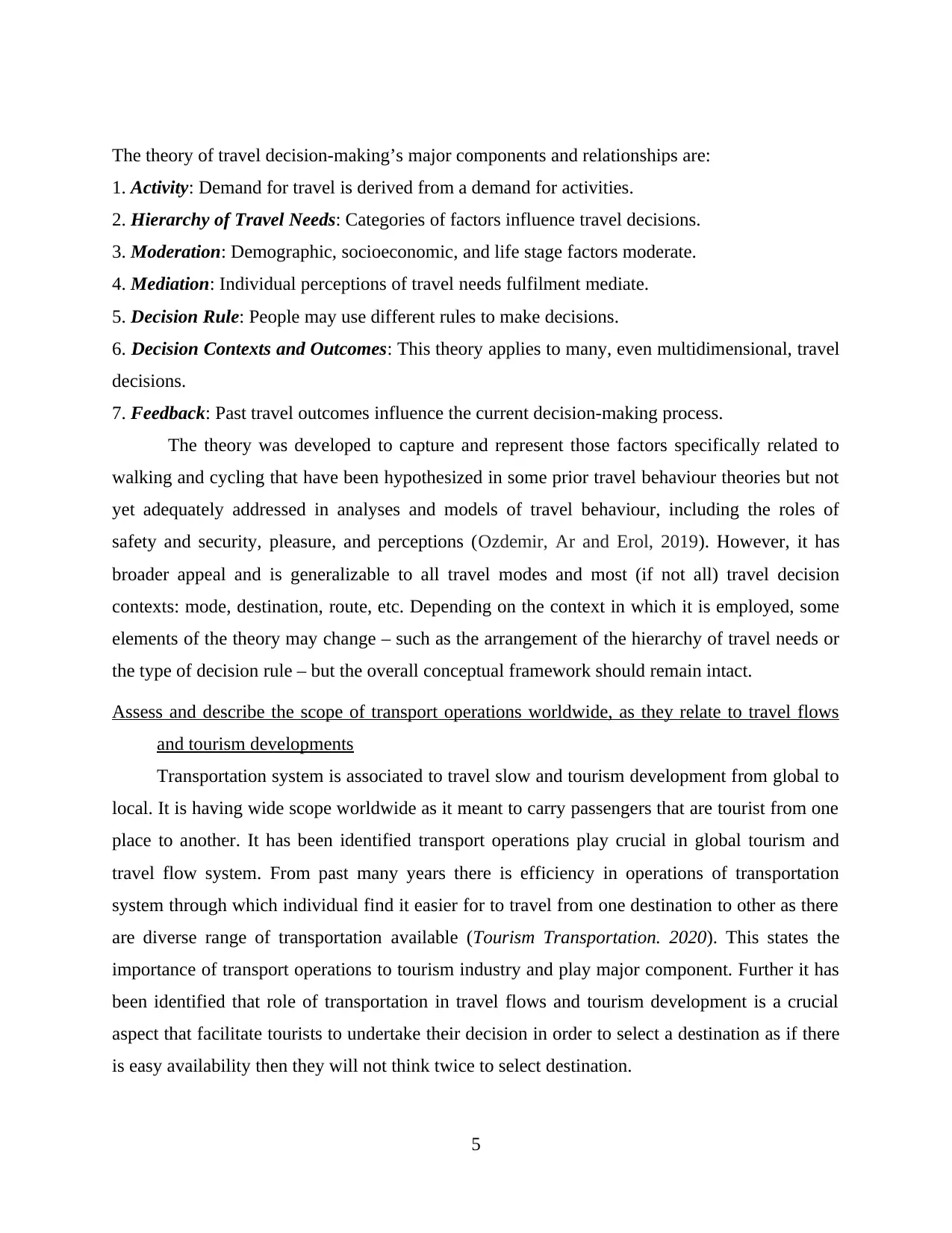
The theory of travel decision-making’s major components and relationships are:
1. Activity: Demand for travel is derived from a demand for activities.
2. Hierarchy of Travel Needs: Categories of factors influence travel decisions.
3. Moderation: Demographic, socioeconomic, and life stage factors moderate.
4. Mediation: Individual perceptions of travel needs fulfilment mediate.
5. Decision Rule: People may use different rules to make decisions.
6. Decision Contexts and Outcomes: This theory applies to many, even multidimensional, travel
decisions.
7. Feedback: Past travel outcomes influence the current decision-making process.
The theory was developed to capture and represent those factors specifically related to
walking and cycling that have been hypothesized in some prior travel behaviour theories but not
yet adequately addressed in analyses and models of travel behaviour, including the roles of
safety and security, pleasure, and perceptions (Ozdemir, Ar and Erol, 2019). However, it has
broader appeal and is generalizable to all travel modes and most (if not all) travel decision
contexts: mode, destination, route, etc. Depending on the context in which it is employed, some
elements of the theory may change – such as the arrangement of the hierarchy of travel needs or
the type of decision rule – but the overall conceptual framework should remain intact.
Assess and describe the scope of transport operations worldwide, as they relate to travel flows
and tourism developments
Transportation system is associated to travel slow and tourism development from global to
local. It is having wide scope worldwide as it meant to carry passengers that are tourist from one
place to another. It has been identified transport operations play crucial in global tourism and
travel flow system. From past many years there is efficiency in operations of transportation
system through which individual find it easier for to travel from one destination to other as there
are diverse range of transportation available (Tourism Transportation. 2020). This states the
importance of transport operations to tourism industry and play major component. Further it has
been identified that role of transportation in travel flows and tourism development is a crucial
aspect that facilitate tourists to undertake their decision in order to select a destination as if there
is easy availability then they will not think twice to select destination.
5
1. Activity: Demand for travel is derived from a demand for activities.
2. Hierarchy of Travel Needs: Categories of factors influence travel decisions.
3. Moderation: Demographic, socioeconomic, and life stage factors moderate.
4. Mediation: Individual perceptions of travel needs fulfilment mediate.
5. Decision Rule: People may use different rules to make decisions.
6. Decision Contexts and Outcomes: This theory applies to many, even multidimensional, travel
decisions.
7. Feedback: Past travel outcomes influence the current decision-making process.
The theory was developed to capture and represent those factors specifically related to
walking and cycling that have been hypothesized in some prior travel behaviour theories but not
yet adequately addressed in analyses and models of travel behaviour, including the roles of
safety and security, pleasure, and perceptions (Ozdemir, Ar and Erol, 2019). However, it has
broader appeal and is generalizable to all travel modes and most (if not all) travel decision
contexts: mode, destination, route, etc. Depending on the context in which it is employed, some
elements of the theory may change – such as the arrangement of the hierarchy of travel needs or
the type of decision rule – but the overall conceptual framework should remain intact.
Assess and describe the scope of transport operations worldwide, as they relate to travel flows
and tourism developments
Transportation system is associated to travel slow and tourism development from global to
local. It is having wide scope worldwide as it meant to carry passengers that are tourist from one
place to another. It has been identified transport operations play crucial in global tourism and
travel flow system. From past many years there is efficiency in operations of transportation
system through which individual find it easier for to travel from one destination to other as there
are diverse range of transportation available (Tourism Transportation. 2020). This states the
importance of transport operations to tourism industry and play major component. Further it has
been identified that role of transportation in travel flows and tourism development is a crucial
aspect that facilitate tourists to undertake their decision in order to select a destination as if there
is easy availability then they will not think twice to select destination.
5
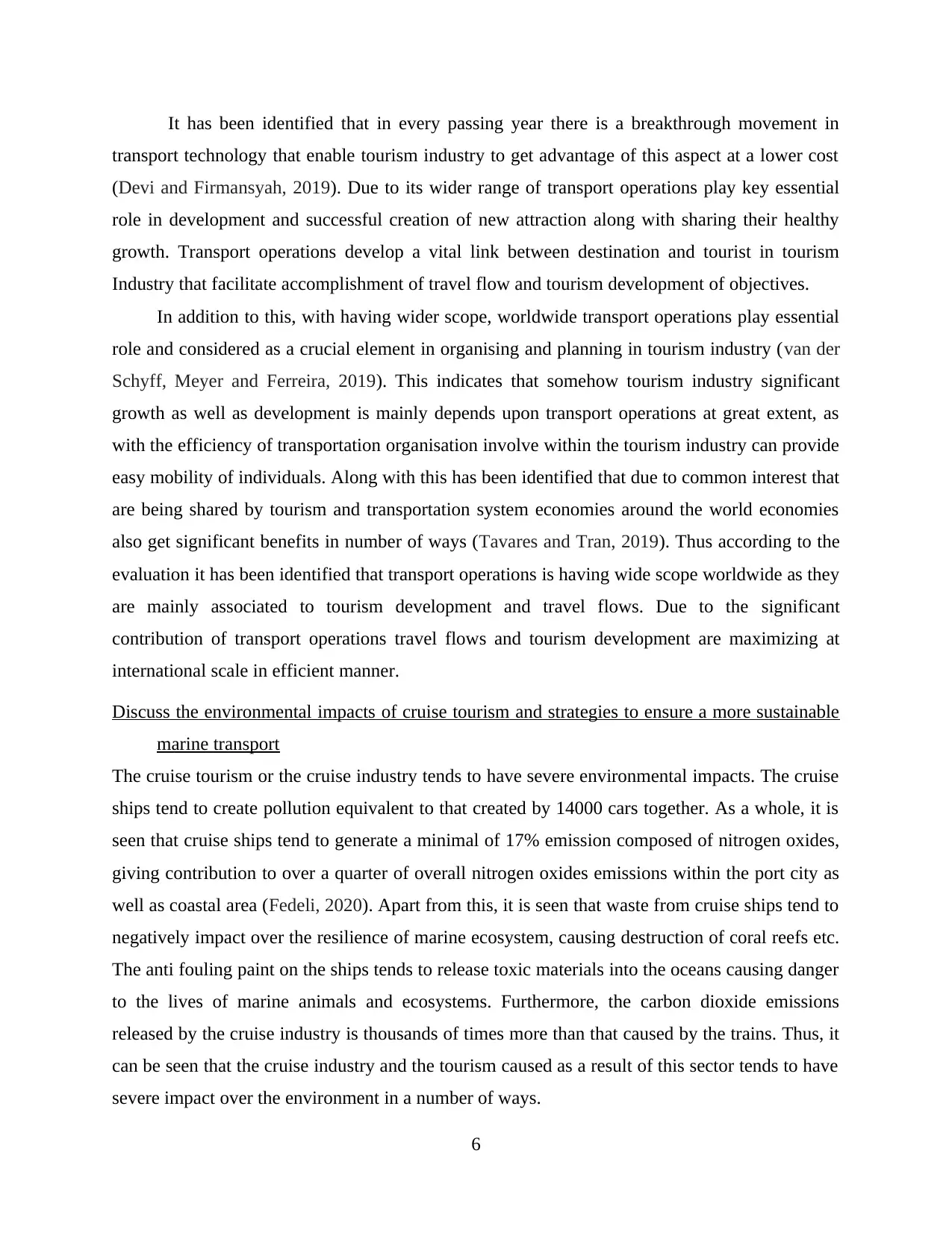
It has been identified that in every passing year there is a breakthrough movement in
transport technology that enable tourism industry to get advantage of this aspect at a lower cost
(Devi and Firmansyah, 2019). Due to its wider range of transport operations play key essential
role in development and successful creation of new attraction along with sharing their healthy
growth. Transport operations develop a vital link between destination and tourist in tourism
Industry that facilitate accomplishment of travel flow and tourism development of objectives.
In addition to this, with having wider scope, worldwide transport operations play essential
role and considered as a crucial element in organising and planning in tourism industry (van der
Schyff, Meyer and Ferreira, 2019). This indicates that somehow tourism industry significant
growth as well as development is mainly depends upon transport operations at great extent, as
with the efficiency of transportation organisation involve within the tourism industry can provide
easy mobility of individuals. Along with this has been identified that due to common interest that
are being shared by tourism and transportation system economies around the world economies
also get significant benefits in number of ways (Tavares and Tran, 2019). Thus according to the
evaluation it has been identified that transport operations is having wide scope worldwide as they
are mainly associated to tourism development and travel flows. Due to the significant
contribution of transport operations travel flows and tourism development are maximizing at
international scale in efficient manner.
Discuss the environmental impacts of cruise tourism and strategies to ensure a more sustainable
marine transport
The cruise tourism or the cruise industry tends to have severe environmental impacts. The cruise
ships tend to create pollution equivalent to that created by 14000 cars together. As a whole, it is
seen that cruise ships tend to generate a minimal of 17% emission composed of nitrogen oxides,
giving contribution to over a quarter of overall nitrogen oxides emissions within the port city as
well as coastal area (Fedeli, 2020). Apart from this, it is seen that waste from cruise ships tend to
negatively impact over the resilience of marine ecosystem, causing destruction of coral reefs etc.
The anti fouling paint on the ships tends to release toxic materials into the oceans causing danger
to the lives of marine animals and ecosystems. Furthermore, the carbon dioxide emissions
released by the cruise industry is thousands of times more than that caused by the trains. Thus, it
can be seen that the cruise industry and the tourism caused as a result of this sector tends to have
severe impact over the environment in a number of ways.
6
transport technology that enable tourism industry to get advantage of this aspect at a lower cost
(Devi and Firmansyah, 2019). Due to its wider range of transport operations play key essential
role in development and successful creation of new attraction along with sharing their healthy
growth. Transport operations develop a vital link between destination and tourist in tourism
Industry that facilitate accomplishment of travel flow and tourism development of objectives.
In addition to this, with having wider scope, worldwide transport operations play essential
role and considered as a crucial element in organising and planning in tourism industry (van der
Schyff, Meyer and Ferreira, 2019). This indicates that somehow tourism industry significant
growth as well as development is mainly depends upon transport operations at great extent, as
with the efficiency of transportation organisation involve within the tourism industry can provide
easy mobility of individuals. Along with this has been identified that due to common interest that
are being shared by tourism and transportation system economies around the world economies
also get significant benefits in number of ways (Tavares and Tran, 2019). Thus according to the
evaluation it has been identified that transport operations is having wide scope worldwide as they
are mainly associated to tourism development and travel flows. Due to the significant
contribution of transport operations travel flows and tourism development are maximizing at
international scale in efficient manner.
Discuss the environmental impacts of cruise tourism and strategies to ensure a more sustainable
marine transport
The cruise tourism or the cruise industry tends to have severe environmental impacts. The cruise
ships tend to create pollution equivalent to that created by 14000 cars together. As a whole, it is
seen that cruise ships tend to generate a minimal of 17% emission composed of nitrogen oxides,
giving contribution to over a quarter of overall nitrogen oxides emissions within the port city as
well as coastal area (Fedeli, 2020). Apart from this, it is seen that waste from cruise ships tend to
negatively impact over the resilience of marine ecosystem, causing destruction of coral reefs etc.
The anti fouling paint on the ships tends to release toxic materials into the oceans causing danger
to the lives of marine animals and ecosystems. Furthermore, the carbon dioxide emissions
released by the cruise industry is thousands of times more than that caused by the trains. Thus, it
can be seen that the cruise industry and the tourism caused as a result of this sector tends to have
severe impact over the environment in a number of ways.
6
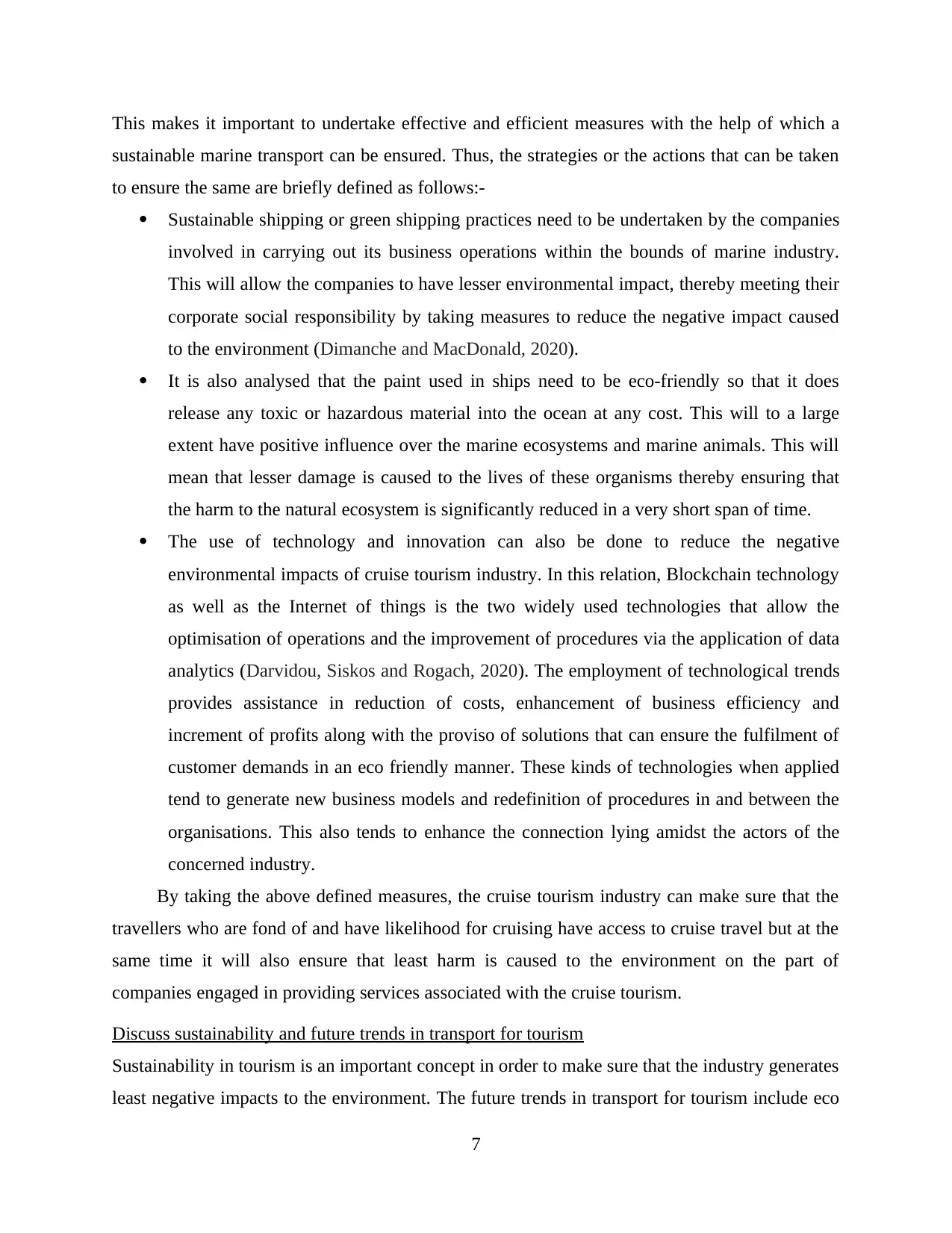
This makes it important to undertake effective and efficient measures with the help of which a
sustainable marine transport can be ensured. Thus, the strategies or the actions that can be taken
to ensure the same are briefly defined as follows:-
Sustainable shipping or green shipping practices need to be undertaken by the companies
involved in carrying out its business operations within the bounds of marine industry.
This will allow the companies to have lesser environmental impact, thereby meeting their
corporate social responsibility by taking measures to reduce the negative impact caused
to the environment (Dimanche and MacDonald, 2020).
It is also analysed that the paint used in ships need to be eco-friendly so that it does
release any toxic or hazardous material into the ocean at any cost. This will to a large
extent have positive influence over the marine ecosystems and marine animals. This will
mean that lesser damage is caused to the lives of these organisms thereby ensuring that
the harm to the natural ecosystem is significantly reduced in a very short span of time.
The use of technology and innovation can also be done to reduce the negative
environmental impacts of cruise tourism industry. In this relation, Blockchain technology
as well as the Internet of things is the two widely used technologies that allow the
optimisation of operations and the improvement of procedures via the application of data
analytics (Darvidou, Siskos and Rogach, 2020). The employment of technological trends
provides assistance in reduction of costs, enhancement of business efficiency and
increment of profits along with the proviso of solutions that can ensure the fulfilment of
customer demands in an eco friendly manner. These kinds of technologies when applied
tend to generate new business models and redefinition of procedures in and between the
organisations. This also tends to enhance the connection lying amidst the actors of the
concerned industry.
By taking the above defined measures, the cruise tourism industry can make sure that the
travellers who are fond of and have likelihood for cruising have access to cruise travel but at the
same time it will also ensure that least harm is caused to the environment on the part of
companies engaged in providing services associated with the cruise tourism.
Discuss sustainability and future trends in transport for tourism
Sustainability in tourism is an important concept in order to make sure that the industry generates
least negative impacts to the environment. The future trends in transport for tourism include eco
7
sustainable marine transport can be ensured. Thus, the strategies or the actions that can be taken
to ensure the same are briefly defined as follows:-
Sustainable shipping or green shipping practices need to be undertaken by the companies
involved in carrying out its business operations within the bounds of marine industry.
This will allow the companies to have lesser environmental impact, thereby meeting their
corporate social responsibility by taking measures to reduce the negative impact caused
to the environment (Dimanche and MacDonald, 2020).
It is also analysed that the paint used in ships need to be eco-friendly so that it does
release any toxic or hazardous material into the ocean at any cost. This will to a large
extent have positive influence over the marine ecosystems and marine animals. This will
mean that lesser damage is caused to the lives of these organisms thereby ensuring that
the harm to the natural ecosystem is significantly reduced in a very short span of time.
The use of technology and innovation can also be done to reduce the negative
environmental impacts of cruise tourism industry. In this relation, Blockchain technology
as well as the Internet of things is the two widely used technologies that allow the
optimisation of operations and the improvement of procedures via the application of data
analytics (Darvidou, Siskos and Rogach, 2020). The employment of technological trends
provides assistance in reduction of costs, enhancement of business efficiency and
increment of profits along with the proviso of solutions that can ensure the fulfilment of
customer demands in an eco friendly manner. These kinds of technologies when applied
tend to generate new business models and redefinition of procedures in and between the
organisations. This also tends to enhance the connection lying amidst the actors of the
concerned industry.
By taking the above defined measures, the cruise tourism industry can make sure that the
travellers who are fond of and have likelihood for cruising have access to cruise travel but at the
same time it will also ensure that least harm is caused to the environment on the part of
companies engaged in providing services associated with the cruise tourism.
Discuss sustainability and future trends in transport for tourism
Sustainability in tourism is an important concept in order to make sure that the industry generates
least negative impacts to the environment. The future trends in transport for tourism include eco
7
Paraphrase This Document
Need a fresh take? Get an instant paraphrase of this document with our AI Paraphraser
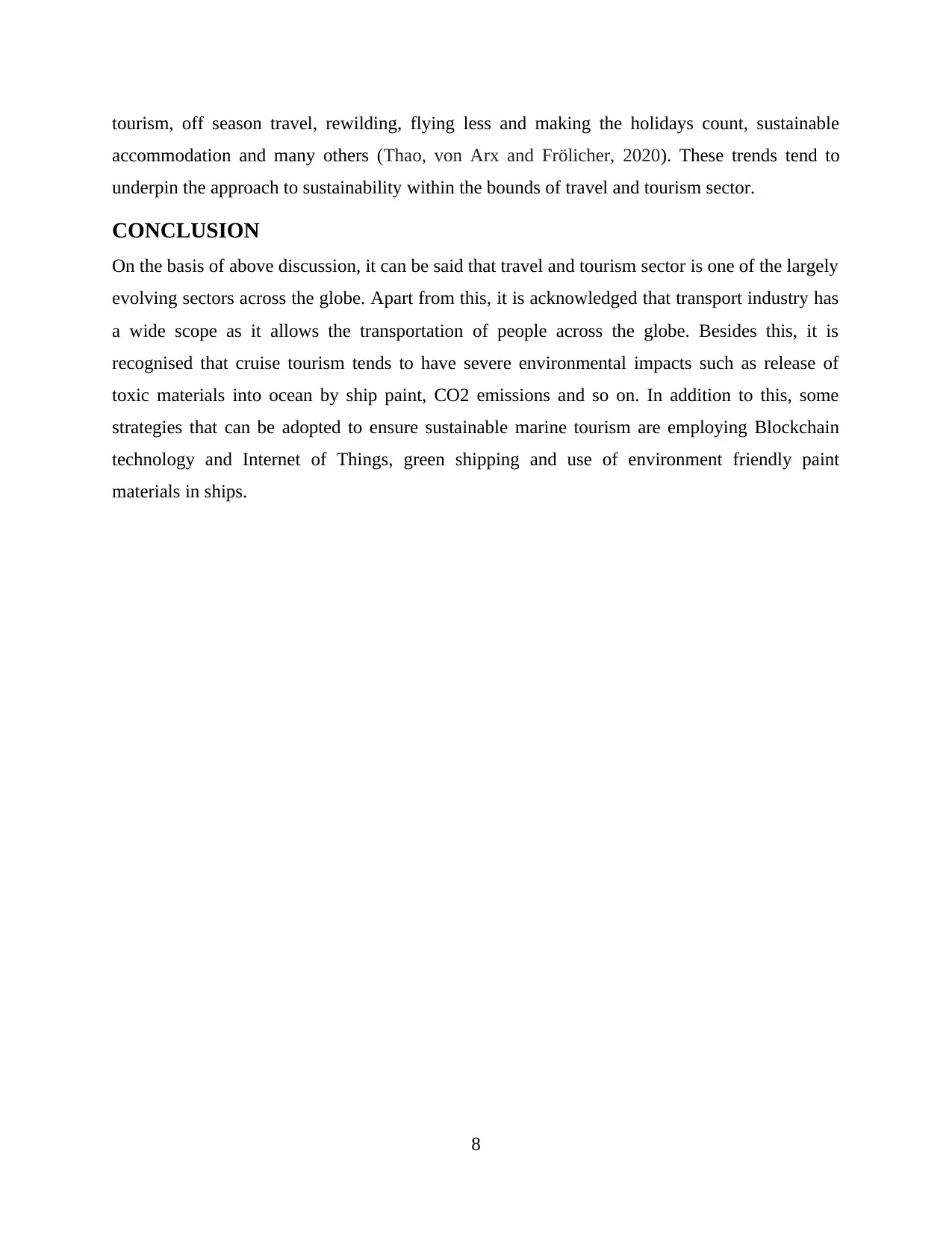
tourism, off season travel, rewilding, flying less and making the holidays count, sustainable
accommodation and many others (Thao, von Arx and Frölicher, 2020). These trends tend to
underpin the approach to sustainability within the bounds of travel and tourism sector.
CONCLUSION
On the basis of above discussion, it can be said that travel and tourism sector is one of the largely
evolving sectors across the globe. Apart from this, it is acknowledged that transport industry has
a wide scope as it allows the transportation of people across the globe. Besides this, it is
recognised that cruise tourism tends to have severe environmental impacts such as release of
toxic materials into ocean by ship paint, CO2 emissions and so on. In addition to this, some
strategies that can be adopted to ensure sustainable marine tourism are employing Blockchain
technology and Internet of Things, green shipping and use of environment friendly paint
materials in ships.
8
accommodation and many others (Thao, von Arx and Frölicher, 2020). These trends tend to
underpin the approach to sustainability within the bounds of travel and tourism sector.
CONCLUSION
On the basis of above discussion, it can be said that travel and tourism sector is one of the largely
evolving sectors across the globe. Apart from this, it is acknowledged that transport industry has
a wide scope as it allows the transportation of people across the globe. Besides this, it is
recognised that cruise tourism tends to have severe environmental impacts such as release of
toxic materials into ocean by ship paint, CO2 emissions and so on. In addition to this, some
strategies that can be adopted to ensure sustainable marine tourism are employing Blockchain
technology and Internet of Things, green shipping and use of environment friendly paint
materials in ships.
8
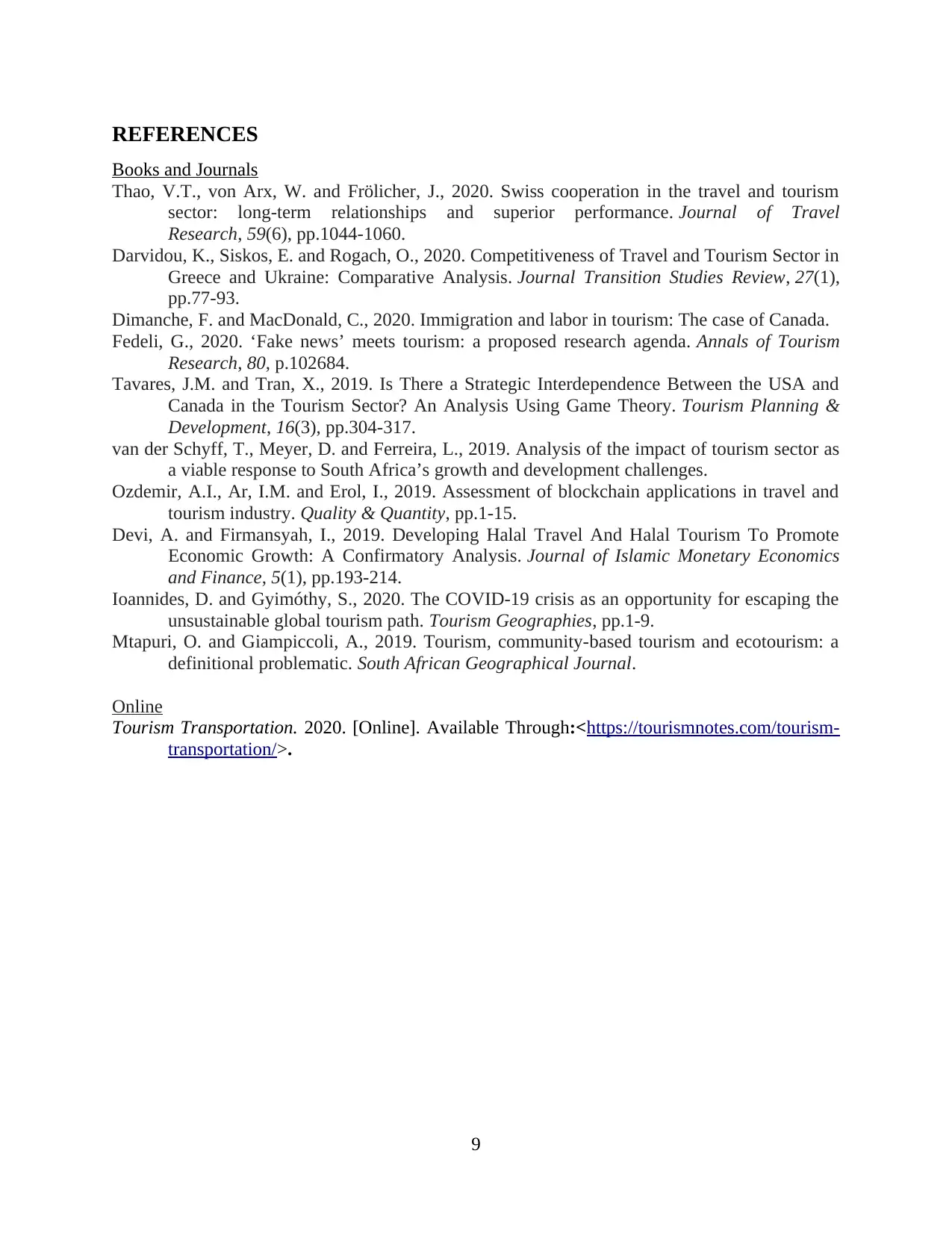
REFERENCES
Books and Journals
Thao, V.T., von Arx, W. and Frölicher, J., 2020. Swiss cooperation in the travel and tourism
sector: long-term relationships and superior performance. Journal of Travel
Research, 59(6), pp.1044-1060.
Darvidou, K., Siskos, E. and Rogach, O., 2020. Competitiveness of Travel and Tourism Sector in
Greece and Ukraine: Comparative Analysis. Journal Transition Studies Review, 27(1),
pp.77-93.
Dimanche, F. and MacDonald, C., 2020. Immigration and labor in tourism: The case of Canada.
Fedeli, G., 2020. ‘Fake news’ meets tourism: a proposed research agenda. Annals of Tourism
Research, 80, p.102684.
Tavares, J.M. and Tran, X., 2019. Is There a Strategic Interdependence Between the USA and
Canada in the Tourism Sector? An Analysis Using Game Theory. Tourism Planning &
Development, 16(3), pp.304-317.
van der Schyff, T., Meyer, D. and Ferreira, L., 2019. Analysis of the impact of tourism sector as
a viable response to South Africa’s growth and development challenges.
Ozdemir, A.I., Ar, I.M. and Erol, I., 2019. Assessment of blockchain applications in travel and
tourism industry. Quality & Quantity, pp.1-15.
Devi, A. and Firmansyah, I., 2019. Developing Halal Travel And Halal Tourism To Promote
Economic Growth: A Confirmatory Analysis. Journal of Islamic Monetary Economics
and Finance, 5(1), pp.193-214.
Ioannides, D. and Gyimóthy, S., 2020. The COVID-19 crisis as an opportunity for escaping the
unsustainable global tourism path. Tourism Geographies, pp.1-9.
Mtapuri, O. and Giampiccoli, A., 2019. Tourism, community-based tourism and ecotourism: a
definitional problematic. South African Geographical Journal.
Online
Tourism Transportation. 2020. [Online]. Available Through:<https://tourismnotes.com/tourism-
transportation/>.
9
Books and Journals
Thao, V.T., von Arx, W. and Frölicher, J., 2020. Swiss cooperation in the travel and tourism
sector: long-term relationships and superior performance. Journal of Travel
Research, 59(6), pp.1044-1060.
Darvidou, K., Siskos, E. and Rogach, O., 2020. Competitiveness of Travel and Tourism Sector in
Greece and Ukraine: Comparative Analysis. Journal Transition Studies Review, 27(1),
pp.77-93.
Dimanche, F. and MacDonald, C., 2020. Immigration and labor in tourism: The case of Canada.
Fedeli, G., 2020. ‘Fake news’ meets tourism: a proposed research agenda. Annals of Tourism
Research, 80, p.102684.
Tavares, J.M. and Tran, X., 2019. Is There a Strategic Interdependence Between the USA and
Canada in the Tourism Sector? An Analysis Using Game Theory. Tourism Planning &
Development, 16(3), pp.304-317.
van der Schyff, T., Meyer, D. and Ferreira, L., 2019. Analysis of the impact of tourism sector as
a viable response to South Africa’s growth and development challenges.
Ozdemir, A.I., Ar, I.M. and Erol, I., 2019. Assessment of blockchain applications in travel and
tourism industry. Quality & Quantity, pp.1-15.
Devi, A. and Firmansyah, I., 2019. Developing Halal Travel And Halal Tourism To Promote
Economic Growth: A Confirmatory Analysis. Journal of Islamic Monetary Economics
and Finance, 5(1), pp.193-214.
Ioannides, D. and Gyimóthy, S., 2020. The COVID-19 crisis as an opportunity for escaping the
unsustainable global tourism path. Tourism Geographies, pp.1-9.
Mtapuri, O. and Giampiccoli, A., 2019. Tourism, community-based tourism and ecotourism: a
definitional problematic. South African Geographical Journal.
Online
Tourism Transportation. 2020. [Online]. Available Through:<https://tourismnotes.com/tourism-
transportation/>.
9
1 out of 9
Related Documents
Your All-in-One AI-Powered Toolkit for Academic Success.
+13062052269
info@desklib.com
Available 24*7 on WhatsApp / Email
![[object Object]](/_next/static/media/star-bottom.7253800d.svg)
Unlock your academic potential
© 2024 | Zucol Services PVT LTD | All rights reserved.



